Recent Articles
Popular Makes
Body Types
2021 Toyota Corolla Hybrid Road Test and Review
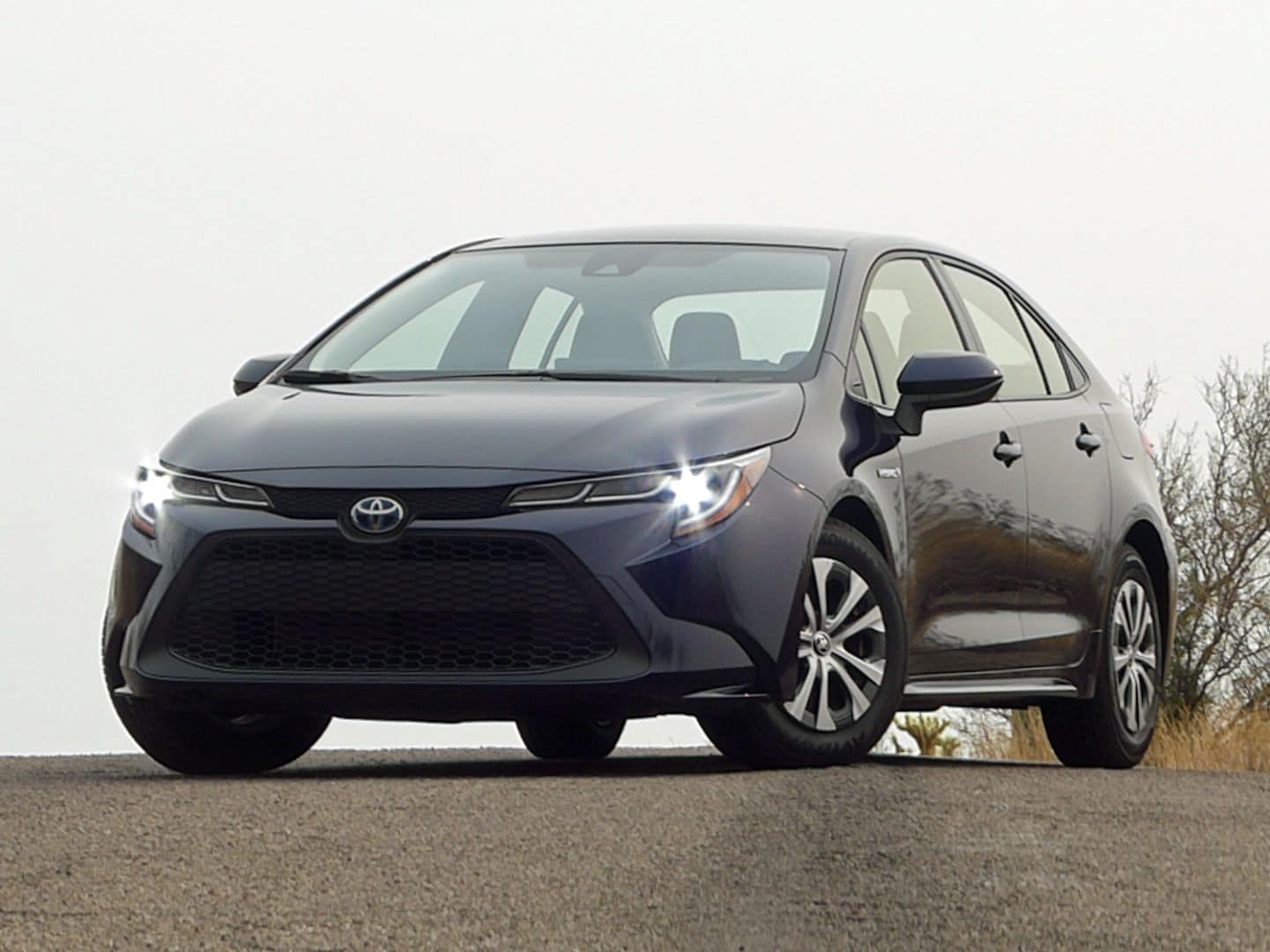
2021 Toyota Corolla Hybrid ・ Photo by Ron Sessions
Introduced just last year, the 2021 Toyota Corolla Hybrid gets the same planet-saving powertrain as the Toyota Prius and nearly the same fuel economy, sans the Flash Gordon styling, nerdy center-mounted dash gauges, and joystick shifter. If you didn’t notice the small Hybrid badges adorning this Corolla’s front fenders and rear decklid, you’d be forgiven for not knowing you were getting into a hybrid.
As hybrids go, the 2021 Corolla Hybrid is a screaming bargain. Buyers get the same technology as the fuel-sipping Prius wrapped in a conventional package. The Corolla Hybrid comes in just one reasonably well-equipped LE trim. It’s not the base rental-car L or the fancy XLE. Including the $995 destination charge, the 2021 Corolla Hybrid LE is priced at $24,495. That’s $2,235 less than the LE-trimmed 2021 Prius.
Prius Powertrain
This is the same well-proven long-stroke Atkinson-cycle 1.8-liter four-cylinder that powers the Toyota Prius without the fancy Toyota hybrid Drive-emblazoned engine cover. Combined with its 53 kW permanent-magnet AC synchronous electric motor, the Corolla Hybrid’s system output is a modest 121 horsepower and 120 lb-ft of torque. That’s good enough to propel the vehicle from rest to 60 mph in just over 10 seconds, about the same as the Prius. The system sends drive torque to the front drive wheels via an electronically controlled continuously variable transmission. Unlike the Prius, all-wheel drive is not an option for the Corolla Hybrid.
The Corolla Hybrid’s chief competitors have a bit more power and accelerative ability. The Hyundai Ioniq’s 1.6-liter four-cylinder engine and electric motor deliver a system output of 139 horsepower and can go from zero to 60 mph in less than 9 seconds. The Honda Insight manages 151 system horsepower from its 1.5-liter four-cylinder and electric motor, giving it the ability to accelerate from zero to 60 mph in just over 7.5 seconds.
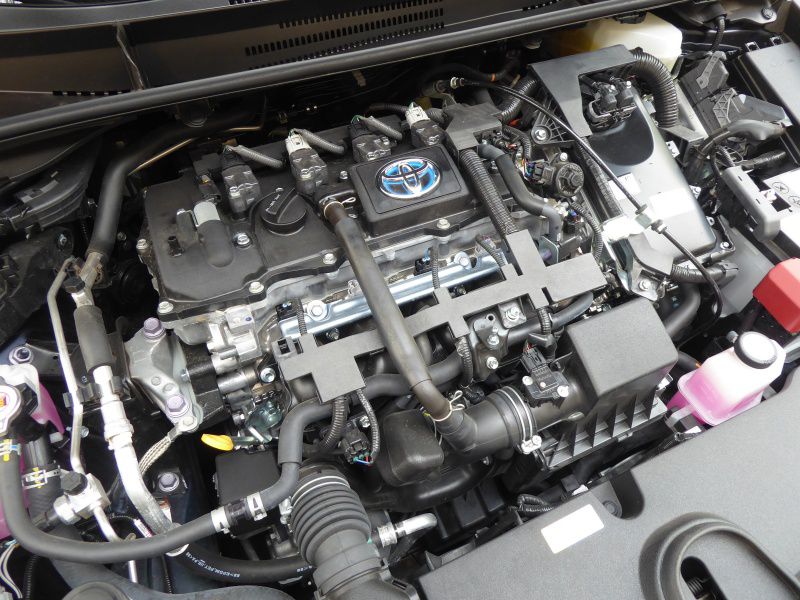
Photo by Ron Sessions
Fuel Economy
Face it, big fuel-economy numbers are a major motivation to buy a hybrid. On this score, the Toyota Corolla Hybrid delivers big time, with EPA estimates of 53 mpg city/52 mpg highway/52 mpg combined. That’s right up there with LE, XLE, and Limited versions of the 2021 Prius (54 mpg city/50 mpg highway/52 mpg) combined as well as competitors such as the Honda Insight (55 mpg city/49 mpg highway/52 mpg combined) and the Hyundai Ioniq (55 mpg city/54 mpg highway/55 mpg combined).
As with the Prius, Toyota makes it easy to keep track of your actual fuel economy through apps on the center infotainment display. And on long trips, the display can provide sort of an eco-aware game of training your accelerator foot and driving style to maximize the car’s mpg score. Or you can ignore the screen and just drive normally. That’s what I did over a week and 150 miles of normal around-town driving, which achieved an average 54 mpg with no hypermiling tricks — like coasting down hills, accelerating extra slowly, drafting semi-trucks, or folding in the side mirrors. Point is, anyone can easily get 50 mpg or better in the Corolla Hybrid in the daily drive without really trying.
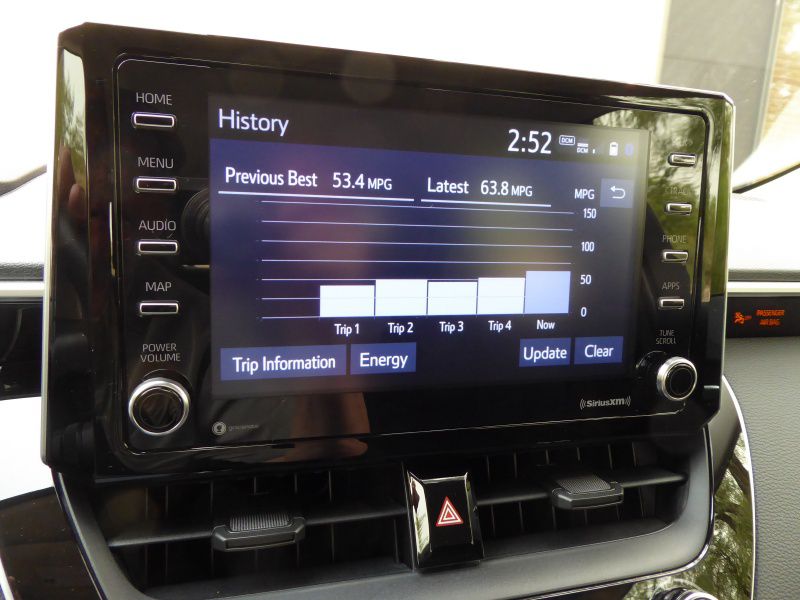
Photo by Ron Sessions
Contemporary Cabin
Just because the Corolla Hybrid is now Toyota’s entry-level offering among its many gas-sippers, it doesn’t shout “entry sedan.” The modern, minimalist instrument panel has a horizontal theme that sweeps cleanly into the door panels. Controls are logically laid out, and button proliferation is kept to a minimum with most grouped together on the steering wheel spokes and around the center stack.
Compared to the previous-generation Corolla, the current one has a lower dash, thinner A-pillars, and relocated side mirrors that help with cross-car outward visibility. It’s fairly quiet for an entry-level car as well, courtesy of extensive soundproofing and an extra-thick acoustic windshield. Standard interior fare includes set-and-forget automatic climate control, a tilt/telescoping steering wheel, cloth-covered seats, a 7-inch driver-configurable color instrument cluster, push-button start, a smart key system for the front doors and trunk, and power door locks, mirrors, and auto up/down windows.
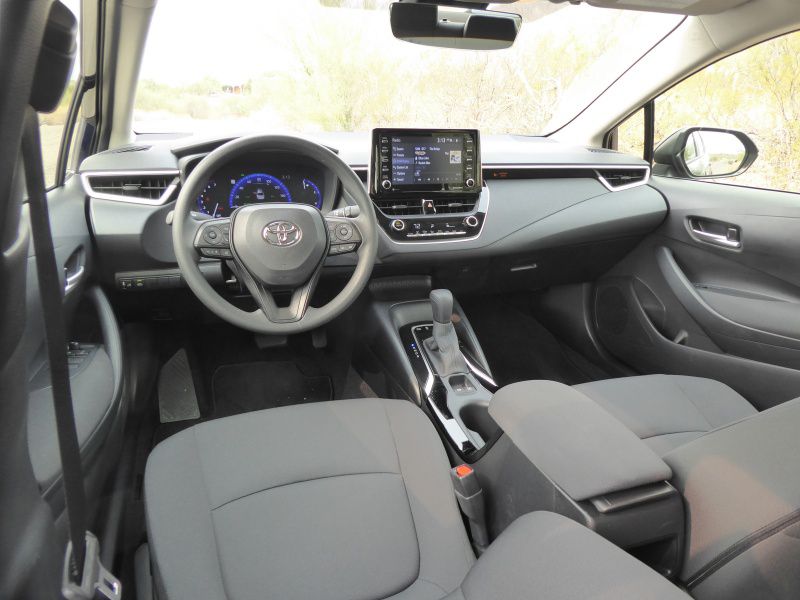
Photo by Ron Sessions
Screen Pass
The 2021 Corolla Hybrid gets the same 8-inch dashtop-mounted infotainment touchscreen as other versions of the Corolla. For 2021, the Corolla adds standard Android Auto to carryover Apple CarPlay cellphone mirroring and voice-activated Alexa functionality. An embedded navigation system is not available, but standard fare includes a Scout GPS navigation link app that works through Bluetooth via your paired cellphone. There is a pair of USB ports up front as well as a 12-volt charging outlet.
The standard audio system is a workable six-speaker AM/FM stereo with SiriusXM capability. The infotainment system content can be accessed via the touchscreen itself, shortcut hard buttons flanking the screen, steering wheel controls, or hands-free voice commands. Good, old-fashioned, effective analog volume and tuning knobs are at the bottom of the screen. Verizon 4G LTE in-car Wi-Fi for up to five devices is standard and available for subscription after a three-month, 2-gigabyte trial. Weather and traffic information is also provided in the included Entune App suite. Wireless charging, HD radio, and the rich-sounding nine-speaker JBL premium audio system optional in higher trims of the regular-issue Corolla are not available in the Corolla Hybrid, however.
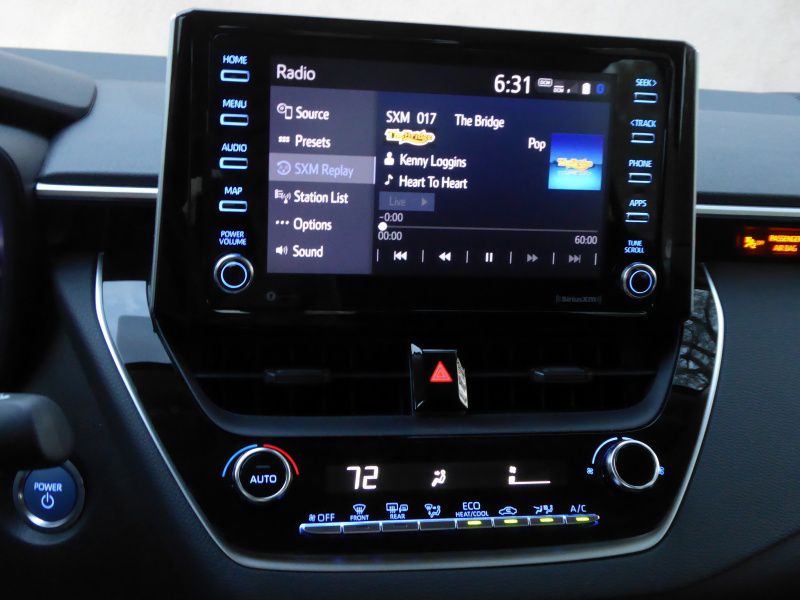
Photo by Ron Sessions
Back Seat
Toyota managed to package the Corolla Hybrid’s lithium-ion battery under the rear seat, so there is no loss of passenger or trunk space. Three adults can fit back there in reasonable comfort, although rear legroom and hip room are markedly less than that offered in the competing Hyundai IONIQ Hybrid or Honda Insight.
A fold-down center armrest with built-in cupholders adds convenience for rear seat occupants, while bins in the rear doors and a pocket on the rear of the front passenger seat add storage space for small items.
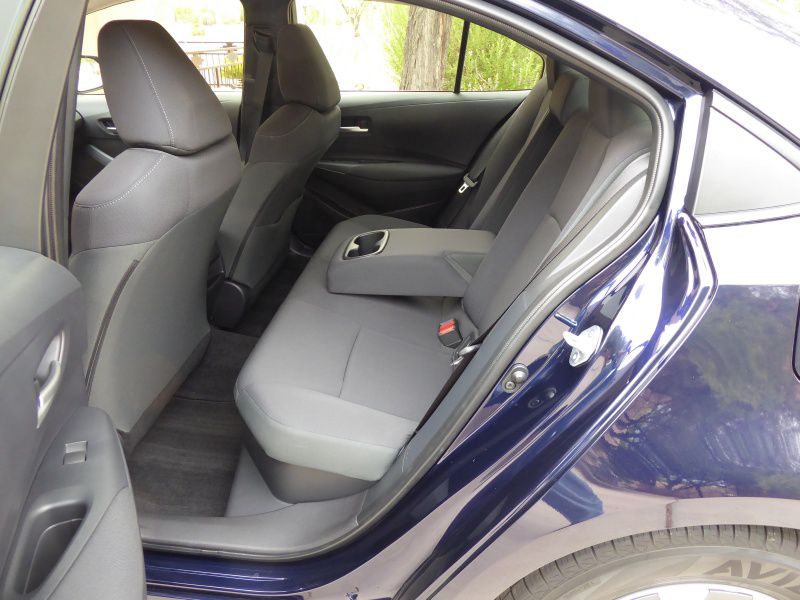
Photo by Ron Sessions
Trunk Talk
One casualty in packaging the Corolla for hybrid duty is the spare tire. The Corolla comes with a tire-repair kit consisting of a can of air and some sealing goop. For anything other than a small puncture, buyers will need a roadside assistance plan.
Although it’s smaller than the Honda Insight’s, the Corolla’s trunk is a useful size and shape, holding up to 13.1 cubic feet of luggage. While that pales in comparison to competing hatchbacks — the Prius at 27.4 cubic feet and the Hyundai Ioniq at 26.5 cubic feet — the placement of the Corolla’s hybrid battery under the floor allows its 60/40 split rear seatbacks to fold down, opening access for additional luggage or longer cargo in the trunk.
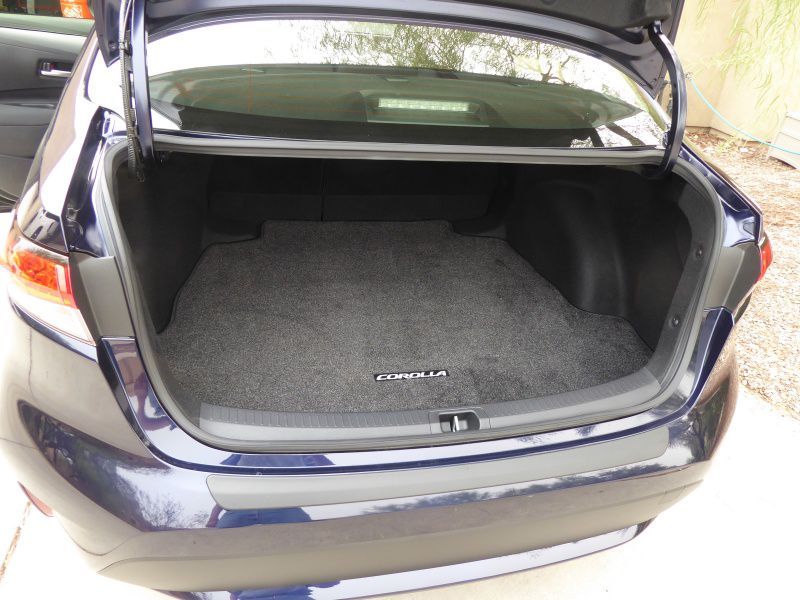
Photo by Ron Sessions
Drive Modes
Like the Prius, the Corolla Hybrid comes standard with driver-selectable drive modes that tailor fuel efficiency and acceleration to individual circumstances. These are selected via a row of buttons ahead of the Corolla Hybrid’s conventional floor-mounted PRNDL shift lever. Normal mode is the default setting for what Toyota considers the best balance of efficiency and acceleration, and it offers linear response to driver inputs. Eco mode skews the balance in favor of improved fuel efficiency but sacrifices a certain degree of throttle response. Sport mode does just the opposite, provided a boost to acceleration response. EV mode allows the Corolla to be driven short distances solely on electric power, such as in indoor parking garages or areas that only allow electric vehicle operation.
There is one more drive mode available, accessed via the gear selector. When the shifter is in the “B” position, the hybrid system’s regenerative braking is increased, decreasing the amount the driver must press on the foot brake to slow or stop the car. Known as “one-pedal” driving, using the “B” position can help reduce driver fatigue in congested stop-and-go traffic.
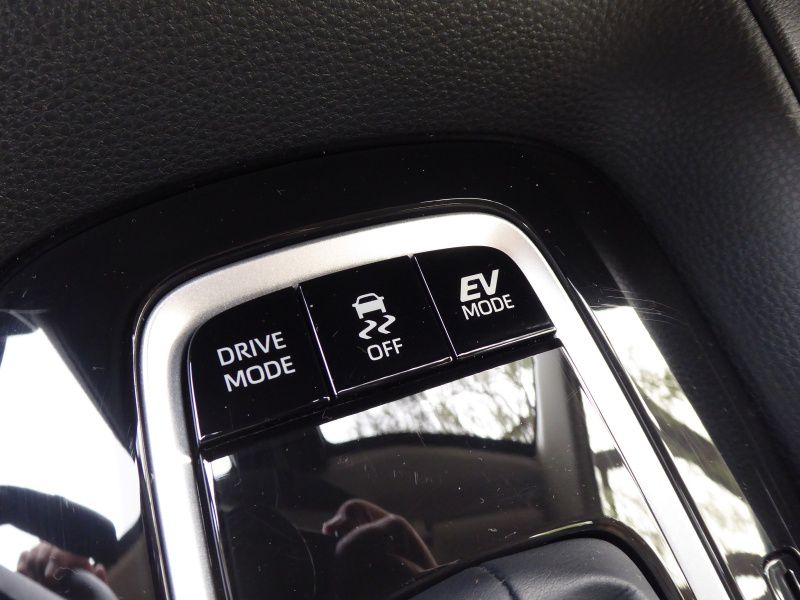
Photo by Ron Sessions
Simply Safe
Unlike many models from premium brands, the Corolla Hybrid sedan comes with an impressive roster of standard advanced safety and driver-assistive technology. Toyota Safety Sense 2.0 includes a pre-collision system with pedestrian and bicycle sensing and automatic emergency braking, a lane-departure alert with steering assist, road sign assist, automatic high beams, lane tracing assist (which helps center the Corolla in its lane), and a backup camera. Also included is dynamic cruise control, which costs extra in many luxury vehicles.
For 2021, the Corolla ups its airbag count from eight to 10 with the addition of standard rear-seat side airbags. A blind-spot monitor and rear cross-traffic alert are now available in an optional $500 package. The Toyota Corolla was a 2020 Insurance Institute for Highway Safety Top Safety Pick with Good scores in small- and moderate-offset front impacts, side impacts, roof strength, head restraints, and seats.
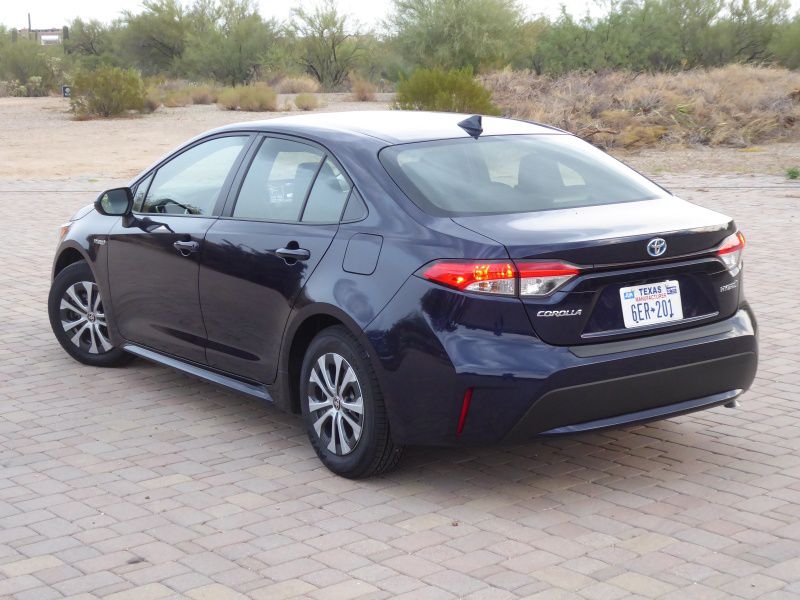
Photo by Ron Sessions
Vehicle Dynamics
While the Corolla Hybrid has no sporting pretensions, its four-wheel independent suspension and stiffer Toyota New Global Architecture adds chassis refinement beyond anything previously available in the Corolla line. Its steering is now nicely weighted and more precise, and the car’s ride and handling balance is more confidence-inspiring.
The blending of the hydraulic foot brakes and the regenerative braking of the hybrid system still leaves something to be desired, however, with uneven response and a general lack of linearity characteristics the driver has to compensate for.
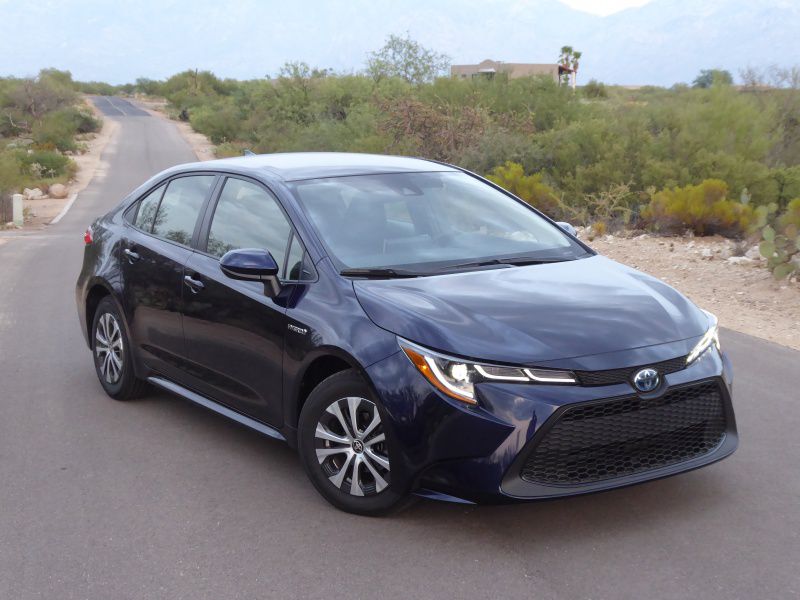
Photo by Ron Sessions
Corolla as Undercover Prius
In recent years, Toyota has been sprinkling Prius fairy dust over most of its passenger-car and crossover suv lineup, applying lessons learned from the nerdy gas-electric hybrid to improve their fuel economy.
Now that Toyota is discontinuing the subcompact Yaris, the compact Corolla becomes the Japanese automaker’s smallest sedan and least-expensive car. With the Corolla Hybrid, Toyota brings Prius-level fuel efficiency to the masses. But unlike the Prius, which shouts its hybrid credentials with edgy styling, no one has to know you’ve gone green driving a Corolla Hybrid. You might call the 2021 Toyota Corolla Hybrid an undercover Prius.
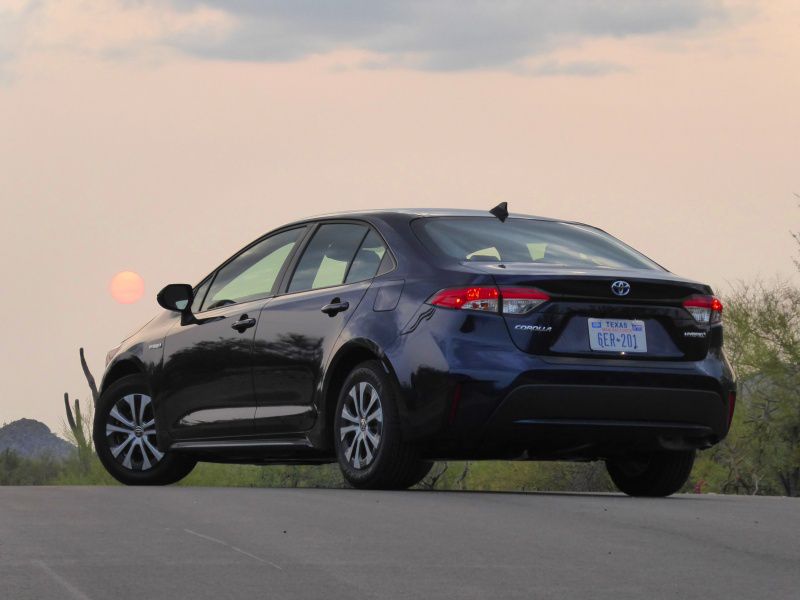
Photo by Ron Sessions